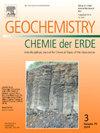The role of fluid overpressure in Cu-Au porphyry mineralization: Evidence from the Oubulage deposit, Inner Mongolia, China
IF 2.9
3区 地球科学
Q2 GEOCHEMISTRY & GEOPHYSICS
引用次数: 0
Abstract
Fluids play a critical role in the formation of porphyry copper (Cu)‑gold (Au) deposits, although the mechanism of metal transport remains enigmatic. The presence of phengite in the Oubulage porphyry Cu-Au deposit in Inner Mongolia provides a unique opportunity to evaluate this problem. In this study, we present results from texture, elemental and isotopic composition of phengite and calcite in the Oubulage quartz porphyry, with a view to understand the role of fluids in the ore genesis. The quartz phenocrysts from this deposit show shock-induced textures, substantial fragmentation, and deformation lamellae in quartz porphyry. The phenocrysts are frequently intersected by veins which consist of phengite, K-feldspar, rutile, ankerite, apatite, and sulfide. Phengite, with Si contents peaking at 3.40 apfu indicates a maximum pressure of approximately 14.4 Kbar. The quartz porphyry shows vesicular and amygdaloidal structures, with vesicular volumes reaching a maximum of 25 %. The elevated Nb + Ta contents and a Nb/Ta ratio exceeding 17.7 in phengite, suggest the important role of supercritical fluids for the origin of phengite. According to the Zr thermometer for rutile, the temperature of these supercritical fluids is approximately 788.3 °C. In-situ carbon‑oxygen isotopic measurements in calcite associated with the sulfide mineralization (δ13CPDB ranging from −6.54 ‰ to −4.26 ‰ and δ18OVSMOW between 8.24 ‰ and 9.13 ‰), and the strontium isotope measurements in apatite (87Sr/86Sr = 0.7056–0.7060) associated with sulfide mineralization, suggest a mantle source for the fluids. We propose that the injection of supercritical fluids rich in Si, Ti, Al, K, Fe, C and F into sulfide melt might have caused fluid overpressure in the magma chamber. This resulted in the fracturing of the phenocryst minerals and formation of high-Si phengite, as well as propelling the upward movement of the ore-bearing melt-fluid towards the upper crust. Our findings also have implications for the exploration of porphyry ore deposits.
流体超压在铜-金斑岩成矿作用中的作用:来自内蒙古乌布勒盖矿床的证据
流体在斑岩铜(Cu)金(Au)矿床的形成中起着关键作用,尽管金属运输的机制仍然是个谜。内蒙古乌布勒格斑岩型铜金矿床中白云石的存在为评价这一问题提供了独特的机会。本文通过对Oubulage石英斑岩中辉云母和方解石的结构、元素组成和同位素组成的分析,了解流体在矿床成因中的作用。该矿床的石英斑晶在石英斑岩中表现出冲击诱发的织构、大量破碎和变形片层。斑晶经常被由斑云母、钾长石、金红石、铁云母、磷灰石和硫化物组成的矿脉相交。硅含量在3.40 apfu时达到峰值的辉长石,其最大压力约为14.4 Kbar。石英斑岩呈泡状和杏仁核状结构,泡状体积最大可达25%。白云岩中Nb + Ta含量升高,Nb/Ta比值超过17.7,表明超临界流体在白云岩成因中起重要作用。根据金红石的Zr温度计,这些超临界流体的温度约为788.3℃。与硫化物成矿作用有关的方解石碳氧同位素(δ13CPDB值在- 6.54‰~ - 4.26‰之间,δ18OVSMOW值在8.24‰~ 9.13‰之间)和与硫化物成矿作用有关的磷灰石锶同位素(87Sr/86Sr = 0.7056 ~ 0.7060)的原位测量结果表明,流体来源于地幔。我们认为,硫化物熔体中富含Si、Ti、Al、K、Fe、C和F的超临界流体的注入可能导致岩浆房流体超压。这导致了斑晶矿物的断裂和高硅斑岩的形成,并推动了含矿熔融流体向上地壳的向上运动。我们的发现对斑岩矿床的勘探也有启示意义。
本文章由计算机程序翻译,如有差异,请以英文原文为准。
求助全文
约1分钟内获得全文
求助全文
来源期刊

Chemie Der Erde-Geochemistry
地学-地球化学与地球物理
CiteScore
7.10
自引率
0.00%
发文量
40
审稿时长
3.0 months
期刊介绍:
GEOCHEMISTRY was founded as Chemie der Erde 1914 in Jena, and, hence, is one of the oldest journals for geochemistry-related topics.
GEOCHEMISTRY (formerly Chemie der Erde / Geochemistry) publishes original research papers, short communications, reviews of selected topics, and high-class invited review articles addressed at broad geosciences audience. Publications dealing with interdisciplinary questions are particularly welcome. Young scientists are especially encouraged to submit their work. Contributions will be published exclusively in English. The journal, through very personalized consultation and its worldwide distribution, offers entry into the world of international scientific communication, and promotes interdisciplinary discussion on chemical problems in a broad spectrum of geosciences.
The following topics are covered by the expertise of the members of the editorial board (see below):
-cosmochemistry, meteoritics-
igneous, metamorphic, and sedimentary petrology-
volcanology-
low & high temperature geochemistry-
experimental - theoretical - field related studies-
mineralogy - crystallography-
environmental geosciences-
archaeometry
 求助内容:
求助内容: 应助结果提醒方式:
应助结果提醒方式:


